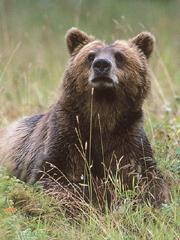|
GRIZZLY BEAR } Ursus arctos horribilis

|
RANGE: Currently found in Alaska, Wyoming, Montana, Idaho, Washington, and possibly southern Colorado, as well as in western Canada.
STATUS: With the exception of a genetically distinct group of bears in Yellowstone National Park, which were delisted in 2007, grizzly bears in the contiguous United States are listed as Threatened under the Endangered Species Act. They are listed as Endangered in parts of Canada, and the International Union for Conservation of Nature considers the brown bear a species of Least Concern.
THREATS: Habitat degradation by development, logging, road building, oil and gas drilling, livestock grazing, and predator control.
Massive and remarkably quick, with distinctive hunched shoulders, a concave face, and long, curved claws the size of human fingers, the grizzly bear is an enduring symbol of the American West. Grizzlies once roamed from Alaska to Mexico and from California to Ohio, even towering over the Central Plains and rumbling through the canyons of the desert Southwest. But the westward expansion of humans into their territory spelled disaster for grizzlies—in just over 100 years, these great bears were pushed out of 98 percent of their habitat, and now they’re really running out of room. Despite the grizzly’s predicament, little is being done to prevent further habitat loss, while government-sponsored predator control poses another major threat its survival.
LEARN MORE ABOUT THE GRIZZLY BEAR
|